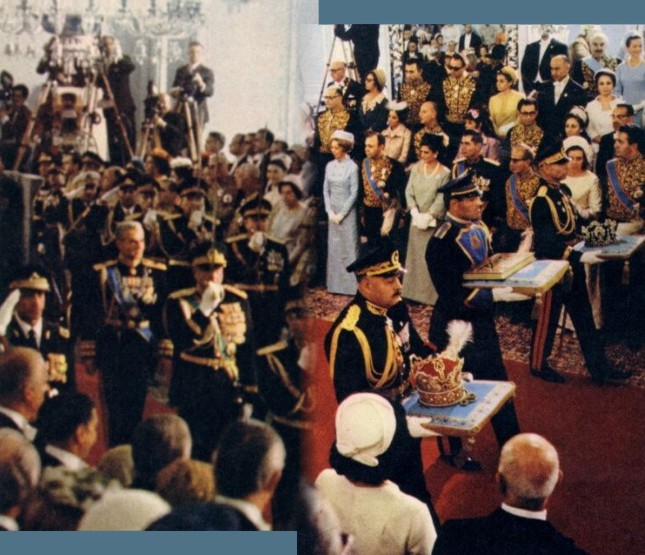


It was evident, apart of the impressive uniform and decorations, that he was not an average young boy. He was the heir of a millenary empire and seemed quite aware of that fact, more than ever on that day, in which he had the consciousness of the burden of responsibility of his father and his own, represented in the ancient and archaic ceremony that was about to begin. He walked the length of the red carpet and went to take his place on what would be the left of his father, on the side of the Diplomatic Corps, where he was regarded with enjoyment and amazement. He did not seat though, and like all the guests he waited standing for the entrance of his parents.


Three minutes later, the eyes turned to the entrance again: the Queen, the Empress, the Shahbanou, followed by 6 maids of honour who took care of the fantastic train of her impressive dress, had entered the Grand Hall of the Golestan Palace. The entrance of Farah was the most impressive sight that is possible to imagine. A journalist in the room, impressed by the allure of the Empress, summed up his impression in a remarkable sentence that he broadcasted to his country saying that the Shahbanou had entered the room “with all the majesty of Cleopatra penetrating in the ancient Court of Egypt.” There aren’t photos to recall the legendary beauty of Cleopatra and maybe it could have been nothing but a legend. Farah’s beauty was there and it could be contemplated by millions in Iran, an Iran she had made happier with the heir she had given, and around the world, the world in which she had made Iran famous.
French royalty magazine Point de Vue wrote in its report of the Coronation: “she slowly went forth, followed by her dames and ladies of honour, simple, tremendously grave, her eyes not moving, her hands together over her dress, as if she was praying, as if she was becoming religious. It was in fact something like that…” Like her son had done, the Empress went to her chair, on what would be the right of her husband and remained standing, waiting for her husband’s entrance. Her maids of honour placed her dress’ train and took their places behind the throne, standing.


Three minutes after the Empress, it was the Shah who entered the Grand Hall, preceded three generals, the most senior military officer of each of the three branches of the Armed Forces: the Imperial Navy, the Air Force and the Army. The Shah walked up the long red carpet, acknowledging the bows and curtsies that came from either sides of the Grand Hall. He was walking towards a ceremony that he had delayed for over a quarter of a century and as he walked towards the Naderi Throne he surely did so confident that his work would make Iran a modern country. He reached the bejewelled throne and turned back to the entrance of the room, standing. His wife, the Empress, curtsied when the Shah arrived at the throne.
Moments later, three officers entered the Grand Hall carrying the Koran, the Imperial Crown of Iran and the Empress of Iran’s Crown. The sight of those magnificent jewels, which would take an essential part in the ceremonial, sparkled the amazement among the large hundreds of guests. The officers, carrying the items over blue cushions with the arms of the Pahlavis embroidered in the centre, steadily progressed in the room and everything was ready then, for the ceremony to start. The Shah climbed on to the Naderi Throne and remained motionless for about ten seconds, looking straight down the room. Everyone remained standing. His Imperial Majesty then bowed at right and at left, acknowledging the homage of the guests and inviting everyone to seat.



